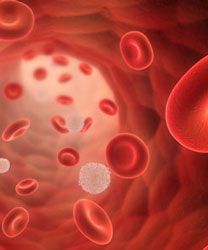R-CVP Associated with 83% 8-Year OS for Advanced Symptomatic Follicular Lymphoma
According to phase III results from the FOLL05 trial, the combination of rituximab plus cyclophosphamide, vincristine, and prednisone produced survival results comparable with standard-of-care regimens in patients with advanced symptomatic follicular lymphoma.
mcl

According to phase III results from the FOLL05 trial, the combination of rituximab (Rituxan) plus cyclophosphamide, vincristine, and prednisone (R-CVP) produced survival results comparable with standard-of-care regimens in patients with advanced symptomatic follicular lymphoma (FL).
Eight-year overall survival (OS) was 83% for R-CVP by an intent-to-treat analysis (95% CI, 79%-87%). It was 85% (95% CI, 77%-91%) for R-CVP compared with 83% (95% CI, 75%-89%) for rituximab plus cyclophosphamide, doxorubicin, vincristine, and prednisone (R-CHOP) and 79% (95% CI, 71%-85%) for rituximab plus fludarabine and mitoxantrone (R-FM).
“The 3 study arms had similar OS but different activity and toxicity profiles,” investigators wrote in the article, which was published in the Journal of Clinical Oncology. “Patients initially treated with R-CVP had a higher risk of lymphoma progression compared with those receiving R-CHOP, as well as a higher risk of requiring additional therapy.”
FOLL05 was a prospective, randomized, open-label, multicenter phase III trial of previously untreated patients with advanced symptomatic FL. Eligible patients had a histologically confirmed diagnosis of grade 1, 2, or 3a FL according to the 2008 WHO classification, Ann Arbor stage II to IV disease, were ages 18 to 75 years with ECOG performance status of 0 to 2, and had active disease according to Italian Society of Hematology guidelines. Exclusion criteria included a diagnosis of grade 3b FL, evidence of histologic transformation into an aggressive lymphoma at the time of diagnosis, CNS involvement, or history of previous malignancy.
From March 2006 to September 2010, 534 patients enrolled in FOLL05 at 58 Italian institutions and assigned to R-CVP (n = 168), R-CHOP (n = 165), or R-FM (n = 171). The intent-to-treat (ITT) population included a total of 504 patients. Median age was 55 years and median follow-up was 84 months. Forty-three patients were lost to follow-up after a median of 64 months.
With prolonged follow-up, the 8-year time-to-treatment failure (TTF) was 44% (95% CI, 39%-49%). It was 45% with R-CHOP (HR, 0.73; 95% CI, 0.55-0.98; P = .033) and 49% with R-FM (HR, 0.70; 95% CI, 0.52-0.93; P = .016), which were both associated with superior rates of TTF than R-CVP (38%).
Investigators recorded 252 progression-free survival (PFS) events, for an 8-year PFS rate of 48% (95% CI, 43%-52%). PFS was 42% (95% CI, 35%-50%) for patients assigned to R-CVP compared with 49% (95% CI, 40-57) for R-CHOP and 52% (95% CI, 45-60) for R-FM.
Overall, 208 of 248 patients who had primary refractory disease or who experienced progressive or relapsed disease required salvage treatment. Ninety patients received conventional immunochemotherapy, 75 underwent autologous stem-cell transplantation (ASCT), 33 were treated with immunotherapy alone, and 10 were treated with radiotherapy alone.
Patients assigned to R-CVP were at greater risk for requiring a second-line therapy (55%) compared with those in the R-CHOP arm (38%) and the R-FM arm (32%). Investigators found that patients treated with R-CVP were 43% more likely to require salvage therapy compared with patients assigned to R-CHOP.
There were 41 secondary malignancies (SMs) recorded during follow-up including 14 hematologic malignancies and 27 solid cancers. Twenty-one SMs were diagnosed in patients who never experienced relapse nor received salvage therapy.
The cumulative incidence of SMs by treatment was 6.2% (95% CI, 2.5%-14.8%) for R-CVP, 12% (95% CI, 7.7%-18.7%) for R-CHOP, and 9.6% (95% CI, 6.0%-15.2%) for R-FM. The HRs for SMs was 2.59 (95% CI, 1.09-6.20; P = .032) between R-CHOP and R-CVP, and 2.29 (95% CI, 0.94-5.56; P = .067) between R-FM and R-CVP.
Forty-six patients (61%) died from disease progression and 29 (39%) died of other causes. There were no fatal infections recorded during induction therapy or among patients who relapsed. The risk for death from lymphoma was similar among the treatment arms (P = .900). The risk for death from non—lymphoma-related causes was higher in the R-FM arm than with R-CVP (11.2% vs 1.8%; P = .005). The difference in non—lymphoma-related cause-specific mortality between R-CVP and R-CHOP was not statistically significant (P = .157).
“This long-term update of the FOLL05 trial confirms the high efficacy of [immunochemotherapy] ICT for the initial treatment of patients with advanced-stage FL in need of therapy,” investigators wrote. “In addition, with the longer follow-up, we can conclude that if the aim of initial therapy is to maximize treatment activity and increase the chance of durable disease control, R-CHOP should be the preferred option among the 3 regimens.”
Luminari S, Ferrari A, Manni M, et al. Long-term results of the FOLL05 trial comparing R-CVP versus R-CHOP versus R-FM for the initial treatment of patients with advanced-stage symptomatic follicular lymphoma [published online ahead of print November 2, 2017]. J Clin Oncol. 2017. doi: 10.1200/JCO.2017.74.1652



